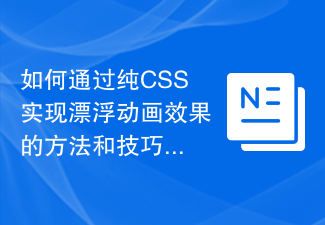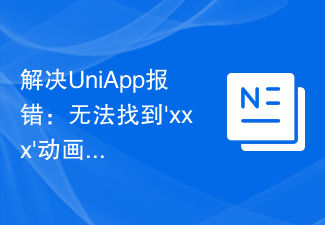 Backend Development
Backend Development PHP Tutorial
PHP Tutorial Implementation of PHP page animation effects and special effects in mini program development
Implementation of PHP page animation effects and special effects in mini program developmentPHP page animation effects and special effects implementation in mini program development
With the continuous development and popularity of mini programs, developers are also constantly pursuing innovation and improving user experience. In the development of small programs, the realization of page animation effects and special effects is an important part. This article will introduce how to use PHP language to achieve animation effects and special effects on mini program pages, and provide some code examples for reference.
1. Implementation of PHP page animation effects
1.1 CSS animation
The most common way to achieve PHP page animation effects is through CSS animation. We can define some CSS styles and then add or remove these styles to trigger animation effects.
For example, we can define a CSS style named "fade-in" to achieve the fade effect:
.fade-in {
opacity: 0;
animation: fade-in-animation 1s forwards;
}
@keyframes fade-in-animation {
0% {
opacity: 0;
}
100% {
opacity: 1;
}
}In PHP, we can use the HTML class attribute to dynamically add or Remove this CSS style to trigger the animation effect:
<?php
$showAnimation = true; // 是否显示动画效果
if ($showAnimation) {
echo '<div class="fade-in">动画内容</div>';
} else {
echo '<div>非动画内容</div>';
}
?>By changing the value of $showAnimation, we can control whether to display the animation effect.
1.2 JavaScript animation library
In addition to CSS animation, we can also use JavaScript animation library to achieve more complex animation effects. PHP can be seamlessly integrated with various JavaScript libraries, such as jQuery, Animate.css, etc.
Taking jQuery as an example, we can use its animate() method to achieve animation effects of page elements. Here is a simple example:
<?php
$showAnimation = true; // 是否显示动画效果
?>
<div id="box">内容</div>
<script src="https://code.jquery.com/jquery-3.6.0.min.js"></script>
<script>
$(document).ready(function() {
<?php if ($showAnimation): ?>
$("#box").animate({left: "200px"}, 1000); // 动画效果
<?php endif; ?>
});
</script>In the above code, we use jQuery's animate() method to move the #box element 200 pixels to the right, with an animation duration of 1 second. By changing the value of $showAnimation, we can control whether to display animation effects.
2. PHP page special effects implementation
2.1 Scroll special effects
Scrolling special effects are one of the common special effects in mini program pages, which can improve the user's visual experience and interaction effect. We can use a combination of PHP and JavaScript to achieve scrolling effects.
The following is a simple example to achieve the effect of displaying a navigation bar when the page scrolls to a specified position:
<?php
$isScrollToTop = true; // 是否滚动到顶部
if ($isScrollToTop) {
echo '<div id="navbar">导航栏</div>';
}
?>
<script src="https://code.jquery.com/jquery-3.6.0.min.js"></script>
<script>
$(window).scroll(function() {
var scrollTop = $(this).scrollTop();
if (scrollTop > 0) {
$("#navbar").fadeIn(); // 显示导航栏
} else {
$("#navbar").fadeOut(); // 隐藏导航栏
}
});
</script>In the above code, we use jQuery's scrollTop() method to obtain the current The scroll position. When the scroll position is greater than 0, the navigation bar is displayed through the fadeIn() method; when the scroll position is 0, the navigation bar is hidden through the fadeOut() method.
2.2 Mouse special effects
Mouse special effects refer to some special effects or feedback that will appear on the page when the user operates the mouse. For example, when the mouse moves over an element, the element will change color or size.
The following is an example. When the mouse moves over the button, the button will have a magnifying effect:
<style>
.button {
padding: 10px 20px;
font-size: 16px;
transition: all 0.3s;
}
.button:hover {
transform: scale(1.2);
}
</style>
<?php
echo '<button class="button">按钮</button>';
?>In the above code, we use the CSS transition attribute and the :hover pseudo-class , to achieve the special effect of button magnification when the mouse moves over the button.
Summary
This article introduces the method of using PHP language to realize mini program page animation effects and special effects, and provides some code examples. By using technologies such as CSS animation and JavaScript animation libraries, developers can add richer animation effects and special effects to mini programs to improve user experience and page interaction effects. I hope this article has inspired everyone and can play a role in the development of small programs.
The above is the detailed content of Implementation of PHP page animation effects and special effects in mini program development. For more information, please follow other related articles on the PHP Chinese website!
 php怎么把负数转为正整数Apr 19, 2022 pm 08:59 PM
php怎么把负数转为正整数Apr 19, 2022 pm 08:59 PMphp把负数转为正整数的方法:1、使用abs()函数将负数转为正数,使用intval()函数对正数取整,转为正整数,语法“intval(abs($number))”;2、利用“~”位运算符将负数取反加一,语法“~$number + 1”。
 Vue页面过渡动画实现及常用动画效果Jun 09, 2023 pm 04:11 PM
Vue页面过渡动画实现及常用动画效果Jun 09, 2023 pm 04:11 PMVue是一款流行的JavaScript框架,它通过数据驱动的方式,协助开发者构建交互性强、数据呈现美观的单页Web应用。Vue内置了许多有用的特性,其中之一就是页面过渡动画。在本文中,我们将介绍如何使用Vue的过渡动画功能,并且讨论最常见的动画效果。实现Vue页面过渡动画Vue的页面过渡动画是通过Vue的<transition>与<tr
 php怎么设置implode没有分隔符Apr 18, 2022 pm 05:39 PM
php怎么设置implode没有分隔符Apr 18, 2022 pm 05:39 PM在PHP中,可以利用implode()函数的第一个参数来设置没有分隔符,该函数的第一个参数用于规定数组元素之间放置的内容,默认是空字符串,也可将第一个参数设置为空,语法为“implode(数组)”或者“implode("",数组)”。
 如何通过纯CSS实现漂浮动画效果的方法和技巧Oct 25, 2023 am 08:10 AM
如何通过纯CSS实现漂浮动画效果的方法和技巧Oct 25, 2023 am 08:10 AM如何通过纯CSS实现漂浮动画效果的方法和技巧在现代网页设计中,动画效果已成为吸引用户眼球的重要元素之一。而其中一种常见的动画效果就是漂浮效果,它可以给网页增加一种动感和活力,使得用户体验更加丰富和有趣。本文将介绍如何通过纯CSS实现漂浮动画效果,并提供一些代码示例供参考。一、使用CSS的transition属性来实现漂浮效果CSS的transition属性可
 使用uniapp实现页面跳转动画效果Nov 21, 2023 pm 02:15 PM
使用uniapp实现页面跳转动画效果Nov 21, 2023 pm 02:15 PM标题:使用uniapp实现页面跳转动画效果近年来,移动应用的用户界面设计已经成为吸引用户的重要因素之一。页面跳转动画效果在提升用户体验和可视化效果方面起着重要的作用。本文将介绍如何使用uniapp实现页面跳转动画效果,并提供具体的代码示例。uniapp是一个基于Vue.js开发的跨平台应用开发框架,可以通过一套代码编译生成小程序、H5、App等多个平台的应用
 解决UniApp报错:无法找到'xxx'动画效果的问题Nov 25, 2023 am 11:43 AM
解决UniApp报错:无法找到'xxx'动画效果的问题Nov 25, 2023 am 11:43 AM解决UniApp报错:无法找到'xxx'动画效果的问题UniApp是一种基于Vue.js框架的跨平台应用开发框架,可以用于开发微信小程序、H5、App等多个平台的应用。在开发过程中,我们经常会使用到动画效果来提升用户体验。然而,有时候会遇到一个报错:无法找到'xxx'动画效果。这个报错会导致动画无法正常运行,给开发带来不便。本文将介绍几种解决这个问题的方法。
 使用uniapp实现页面过渡动画效果Nov 21, 2023 pm 02:38 PM
使用uniapp实现页面过渡动画效果Nov 21, 2023 pm 02:38 PM随着移动互联网的快速发展,越来越多的程序员开始使用uniapp构建跨平台应用。在移动应用开发中,页面过渡动画对用户体验升级起着非常重要的作用。通过页面过渡动画,能够有效地增强用户体验,提高用户留存率和满意度。因此,下面就来分享一下如何使用uniapp实现页面过渡动画效果,同时提供具体代码示例。一、uniapp介绍uniapp是DCloud开发团队推出的一款基
 UniApp实现动画效果与特效展示的设计与开发指南Jul 05, 2023 am 10:01 AM
UniApp实现动画效果与特效展示的设计与开发指南Jul 05, 2023 am 10:01 AMUniApp实现动画效果与特效展示的设计与开发指南一、引言UniApp是一个基于Vue.js的跨平台开发框架,它能够帮助开发者快速、高效地开发出适配多个平台的应用程序。在移动应用开发中,动画效果和特效展示往往能够增强用户体验,提升应用的吸引力。本文将介绍如何在UniApp中实现动画效果与特效展示。二、动画效果的实现在UniApp中,可以使用全局动画库uni-


Hot AI Tools

Undresser.AI Undress
AI-powered app for creating realistic nude photos

AI Clothes Remover
Online AI tool for removing clothes from photos.

Undress AI Tool
Undress images for free

Clothoff.io
AI clothes remover

AI Hentai Generator
Generate AI Hentai for free.

Hot Article

Hot Tools

Safe Exam Browser
Safe Exam Browser is a secure browser environment for taking online exams securely. This software turns any computer into a secure workstation. It controls access to any utility and prevents students from using unauthorized resources.

Notepad++7.3.1
Easy-to-use and free code editor

MantisBT
Mantis is an easy-to-deploy web-based defect tracking tool designed to aid in product defect tracking. It requires PHP, MySQL and a web server. Check out our demo and hosting services.

Dreamweaver CS6
Visual web development tools

ZendStudio 13.5.1 Mac
Powerful PHP integrated development environment





